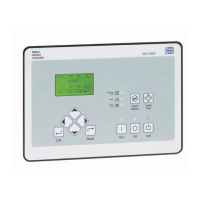9400200990 Rev I DGC-2020 LSM-2020 (Load Share Module) 8-3
FUNCTIONAL DESCRIPTION
Load Share Overview
A generator is paralleled with other generators on an island system, which is not connected to the utility.
The generator shares load with other generators on the system via the load share line. The load share
line of a generator is driven in proportion to the per unitized kW generation of the generator. The voltage
at the junction of all load share lines is proportional to the per unitized average power generation of the
system. For example, if the load share line operating voltage is 0 to 3 volts, and the measured voltage at
the intersection point is 2 volts, the system is at 2/3 of its kW capacity. The generator uses the measured
load share line input value to calculate per unitized average load level, and uses that as the setpoint for
its kW controller.
A generator has a set of contacts that physically disconnects it from the load share line circuit. These
contacts are open whenever the unit’s generator breaker is open.
If a unit or set of units is paralleled to the utility, they derive their setting from the Mains Parallel Power
Level setting, and disregard the load share line input.
Settings are provided to allow a generator to make a bumpless transition onto the system that is
participating in load sharing. A bumpless transition is also achieved when the generator is brought offline.
Analog Outputs
There are three analog outputs: AVR control, GOV control, and Load Share Line. Each output is
described in the following paragraphs.
Output for Voltage Regulator Control
The AVR output provides remote control of the generator voltage setpoint
Output for Governor Control
The GOV output provides remote control of the generator speed setpoint.
Load Share Line Output
The generator uses the measured LS (Load Share Line) output to calculate per unitized average load
level, and uses that as the set point for its kW controller.
Generator Sequencing
Machines can be added or removed from the power system based on load demand. The following criteria
should be considered before adding or removing a machine:
• Machine Priority
• Engine Run Time
• Machine Size
• kW% of the load/demand
• Out of Service machines
Communications
The LSM-2020 communication ports include CAN terminals and an ethernet port.
CANBus
A Control Area Network (CAN) is a standard interface that enables communication between the LSM-
2020 and the DGC-2020.
Ethernet Port
An ethernet port provides communications via BESTCOMSPlus to the LSM-2020 and to the DGC-2020
that the module is connected to. Ethernet communication between LSM-2020s allows for generator
sequencing on an islanded system. Firmware updates to the LSM-2020 are made through the ethernet
port. Firmware updates to the DGC-2020 are only available through the USB port of the DGC-2020. Refer
to Section 4, BESTCOMSPlus, for information on updating firmware in the DGC-2020.
www . ElectricalPartManuals . com

